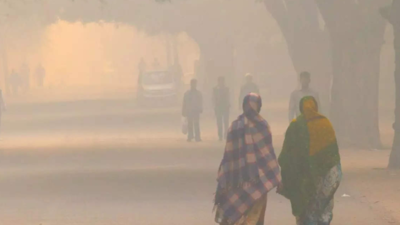- News
- City News
- lucknow News
- Air pollution in Lucknow worse than pre-pandemic levels
Air pollution in Lucknow worse than pre-pandemic levels

The situation is even more alarming since PM2.5 concentrations were recorded above the permissible limits in all the nine localities — four residential and commercial each (Image used for representational purpose only)
LUCKNOW: The city's air quality has worsened drastically once again and so much so that it has even surpassed the high pollution levels recorded in the pre-Covid times. The hazardous PM 2.5 concentration in the pre-monsoon season has increased by 43.9% as compared to last year. Moreover, the PM 2.5 concentration levels were 10% more than in 2019.
Indiranagar and Charbagh were the areas with the most polluted air in the city. These figures were revealed in the report titled 'Assessment of Ambient Air Quality of Lucknow city: Pre-Monsoon 2022', released by the CSIR-Indian Institute of Toxicology Research on Saturday, the eve of World Environment Day. The report shows the average concentration of deadly pollutant this pre-monsoon was 92.8 micrograms, far above permissible limit of 60 micrograms, and higher than 84.3 micrograms recorded in pre-Covid times in 2019 when industrial, commercial, and other activities were in full swing like this year.
 IITR chief scientist GC Kisku, who led the air monitoring survey, attributed the rise to increase in construction activities and vehicular load that led to traffic snarls, fuel combustion and road dust dispersion. Open garbage and municipal solid waste burning and weather conditions due to less rain are the main reasons for this pollution spike, he added. The situation is even more alarming since PM2.5 concentrations were recorded above the permissible limits in all the nine localities — four residential and commercial each, and one industrial monitored by IITR.
IITR chief scientist GC Kisku, who led the air monitoring survey, attributed the rise to increase in construction activities and vehicular load that led to traffic snarls, fuel combustion and road dust dispersion. Open garbage and municipal solid waste burning and weather conditions due to less rain are the main reasons for this pollution spike, he added. The situation is even more alarming since PM2.5 concentrations were recorded above the permissible limits in all the nine localities — four residential and commercial each, and one industrial monitored by IITR.
In residential areas, Indiranagar was the most polluted with the highest PM2.5 concentration followed by Aliganj, Gomtinagar and Vikasnagar, while in commercial areas Charbagh was the most polluted followed by Chowk, Alambagh and Aminabad. “The vehicles on the road have increased by 5.4% as compared to last year and the consumption of CNG gas has gone up by 157.98%. Petrol consumption has also increased by 4.43%,” said Kisku. He said CNG vehicles like taxis have increased by 34.9% while Omni buses have increased by 11.9%.
Fuel combustion is one of the main reasons behind the increase in PM2.5 concentration, he added. The increase in air pollution levels can take a toll on human health as studies have found that PM2.5 penetrates deep into lungs, corrodes the alveolar wall and consequently impairs lung function. Further studies in toxicology and related fields have revealed that the pollutant has increased human mortality rate and diseases. Air pollution has led to a decrease in average life span from months to a few years, he added.
Indiranagar and Charbagh were the areas with the most polluted air in the city. These figures were revealed in the report titled 'Assessment of Ambient Air Quality of Lucknow city: Pre-Monsoon 2022', released by the CSIR-Indian Institute of Toxicology Research on Saturday, the eve of World Environment Day. The report shows the average concentration of deadly pollutant this pre-monsoon was 92.8 micrograms, far above permissible limit of 60 micrograms, and higher than 84.3 micrograms recorded in pre-Covid times in 2019 when industrial, commercial, and other activities were in full swing like this year.

In residential areas, Indiranagar was the most polluted with the highest PM2.5 concentration followed by Aliganj, Gomtinagar and Vikasnagar, while in commercial areas Charbagh was the most polluted followed by Chowk, Alambagh and Aminabad. “The vehicles on the road have increased by 5.4% as compared to last year and the consumption of CNG gas has gone up by 157.98%. Petrol consumption has also increased by 4.43%,” said Kisku. He said CNG vehicles like taxis have increased by 34.9% while Omni buses have increased by 11.9%.
Fuel combustion is one of the main reasons behind the increase in PM2.5 concentration, he added. The increase in air pollution levels can take a toll on human health as studies have found that PM2.5 penetrates deep into lungs, corrodes the alveolar wall and consequently impairs lung function. Further studies in toxicology and related fields have revealed that the pollutant has increased human mortality rate and diseases. Air pollution has led to a decrease in average life span from months to a few years, he added.
FOLLOW US ON SOCIAL MEDIA
FacebookTwitterInstagramKOO APPYOUTUBE
Looking for Something?

Start a Conversation
end of article
Visual Stories
Quick Links
UP NewsDelhi TemperatureChennai WeatherBangalore TemperatureSidhu Moose WalaCoronavirus in DelhiRTPCR test in GurgaonHyderabad RainPollution level in BangaloreDelhi SmogDelhi TemperatureNoida AQIGurgaon AQI todayFire in MumbaiMumbai RainsCovid 19 RT PCR Test in NoidaDelhi AQI todaySrinagar encounter

